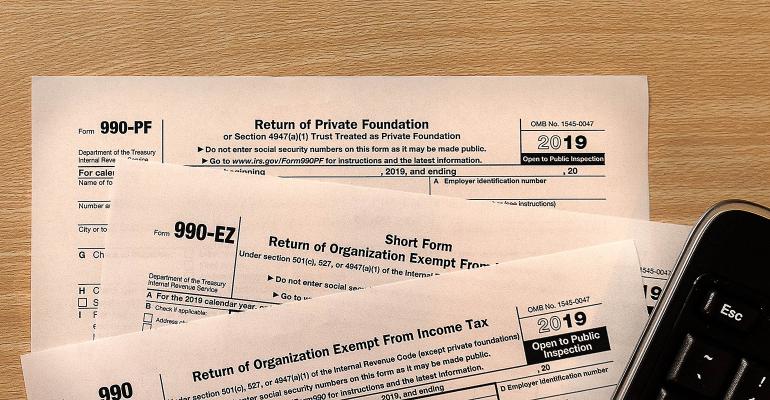Over the years, we’ve examined thousands of tax returns of private foundations (PFs). We’ve found that many tax practitioners are unfamiliar with the nuances of the form, which is highly specialized. They therefore may miss important opportunities for the PF and unknowingly subject the PF to scrutiny.
Missed Opportunities
These often-missed opportunities on the 990-PF can reap savings for PFs:
- Not counting administrative expenses. Some preparers are under the misconception that only grants will satisfy a PF’s minimum distribution requirement (MDR). In fact, legitimate administrative expenses count toward the satisfaction of the MDR, and not counting them can cause a PF to scramble, making hasty grants (and perhaps wasting funds) to avoid a shortfall penalty. A better understanding of qualifying expenses can maximize the funds available for planned, strategic grantmaking.
- Not using investment-related expenses to offset investment income. Frequently, return preparers fail to apply investment-related expenses to offset the investment income, resulting in a higher tax bill for the PF.
- Failing to determine eligibility for the reduced 1% tax rate. The excise tax on net investment income for PFs has historically been a default rate of 2%, with the possibility of reducing such rate to 1% when certain distribution requirements are met. Although recent legislation has simplified the excise tax rate to a flat rate of 1.39% for tax years beginning after Dec. 20, 2019, it’s important to ensure that the section for determining eligibility for the 1% rate is completed on all returns for tax years beginning prior to such date. Based on our experience, preparers often fail to complete this part of the return altogether!
- Failing to properly calculate excess grant carryover. For any year in which a PF grants significantly more than its MDR, the excess grants may be “banked” as grant carryover to help satisfy a future year’s MDR. The carryovers expire if not applied toward the PF’s MDR within five years. When preparers calculate and apply carryovers incorrectly, the damage isn’t limited to a lost opportunity. Miscalculations actually place the PF’s true MDR in doubt and create the false and dangerous impression that the PF has satisfied its MDR when it hasn’t. Correction may require filing several years’ worth of amended returns.
Common Pitfalls
The 990-PF is a potential minefield for the unwary or inexperienced tax preparer. Here are just a few of the most common mistakes:
Failing to fully and properly complete the form. Preparers commonly make several general errors. First, there are often inaccuracies reflecting assets on the balance sheet. In addition, the capital gains or loss on the sale of a donated asset is often improperly calculated due to a failure to apply the donor’s carryover basis. Finally, many returns are submitted without mandatory attachments or schedules. These errors can cause confusion for an Internal Revenue Service reviewer or a miscalculation of the excise tax due, leading to additional penalties.
Calculating the MDR incorrectly. Often, return preparers miscalculate the MDR, arriving at a figure much lower than the actual amount. If a PF fails to meet its MDR in a given year, it will be required to file a penalty return, Form 4720, and will be subject to a 30% penalty on the shortfall amount.
Using the accrual method of accounting to show satisfaction of MDR. Treasury regulations mandate that even PFs using this common method of accounting for financial reporting purposes must use cash basis accounting to determine whether a PF has met its MDR. Using the accrual method could lead to a 30% penalty.
Failing to make estimated tax payments. Larger PFs with even moderate investment income may be required to make quarterly estimated tax payments. Without proper guidance from their preparers, many PFs incur penalties for failure to make these interim payments on time—or at all.
Failing to track foundation insiders. A PF is expected to keep track of all individuals and organizations that are considered insiders (technically, “disqualified persons”). Insiders, who include substantial contributors to the PF, are prohibited from engaging in financial transactions with the PF (for example, sales, loans and leases). Engaging in them may result in a self-dealing violation and penalty. Any insider who engages in a self-dealing transaction is personally responsible for a 10% penalty, which can’t be forgiven by the IRS even if inadvertent, well-intentioned and beneficial to the PF. Preparers often fail to report substantial contributors properly on the annual return and fail to keep track of who’s a substantial contributor with respect to the PF. As a result, a PF’s board or officers may not realize that certain individuals or companies are considered insiders with respect to the PF and may permit the PF to engage in forbidden transactions.
Jeffrey Haskell, J.D., LL.M. is chief legal officer for Foundation Source, which provides comprehensive support services for private foundations. Contact him at [email protected].





